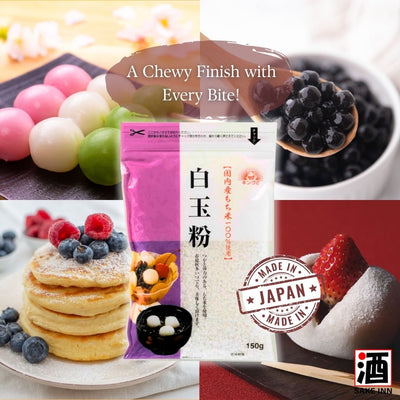Elevate Your Chinese Year Dishes

With Chinese New Year just around the corner, elevate your CNY dishes with our special and easy recipes. Traditionally, during the New Year, families will cook up a feast for our reunion dinners. However, some of these dishes can be easily made at home. In this blog, we are going to show you a recipe with an alternative take on pineapple tarts and pen cai (teasure pot). Advantages of cooking and making these at home includes controlling the amount of sodium and sugar intake. Not to mention that you can customize the ingredients according to your preferences. So wow your guests with our umeshu pineapple tarts and sake pen cai recipes!
Pineapple Tarts
Umeshu Pineapple Tart Recipe
-
2 whole pineapples (or 2kg pineapple flesh)
-
½ tablespoon clove (optional)
-
1 cinnamon stick
-
100g of sugar
- 80ml Ozeki Nigori Umeshu
-
350g unsalted butter, room temperature
-
1 egg yolk
-
500g all-purpose flour
- pinch of salt
-
egg wash (1 egg yolk c+ ½ teaspoon oil)
-
In a large bowl, combine flour and salt.
-
Add butter and mix until a coarse mixture forms.
-
Add in egg, Ozeki Nigori Umeshu, pinch of salt and knead gently. Avoid over kneading.
-
Roll dough into a ball, wrap it in plastic and refrigerate for at least 4 hours (or overnight).
- Cut and blend pineapples. Sieve some of the pineapple juice out to shorten jam cooking time.
-
In a saucepan, add pineapple, cinnamon stick and clove.
-
Cook over medium heat for about 25 minutes or until pineapple puree becomes drier.
-
Reduce heat, add sugar and simmer. Stir frequently until mixture is like a jam-like consistency.
-
Remove cinnamon stick and clove. Remove from heat and allow it to cool.
-
Preheat oven to 200°C
-
Add Ozeki Nigori Umeshu into the dough and knead gently.
-
Roll dough out into a sheet, 1/4 inch thick.
-
Using a 2 inch round fluted cutter (or pineapple tart mould), cut out as many shapes as you can.
-
Roll a spoonful of pineapple filling & place pineapple filling in the centre of the dough.
-
Line pineapple tarts on baking tray lined with baking paper.
-
Brush pastry with egg wash and bake at 180°C for 20 - 25 minutes. Cool on wire rack for 30 mins before storing them.
Storage: store them in an airtight container for about 2 months at room temperature away from sunlight or a up to 6 months in the fridge.
Sake Pen Cai (Treasure Pot)

-
½ broccoli, cut into florets
-
½ Chinese cabbage, cut
- ½ daikon, cut
-
6 prawns, shells intact & steamed with ginger slices
-
6 abalone (reserve abalone broth)
-
3 medium-sized sea cucumbers, cut in thirds
-
6 dried oysters, soak in water
-
8 dried scallops, rinsed and soaked (reserve soaking water)
-
8 Chinese mushrooms, stems trimmed (if dried, soak in hot water & reserve soaking water)
-
100g fish maw, soaked in hot water until softened
-
Optional: 250g of roast pork belly, duck meat, handful of fa cai (black moss)
-
1 tablespoon oyster sauce
-
½ - 1 tablespoon dark soy sauce
-
1 tablespoon shaoxing wine
-
dash of white pepper
-
1000ml chicken stock
-
cornstarch solution
-
Add broccoli in boiling water. Blanch for 3 minutes.
-
Place broccoli in an ice bath, drain and set aside.
-
Blanch Chinese cabbage for 1 min. Drain and set aside.
-
Layer broccoli and Chinese cabbage in claypot
-
Boil chicken stock in a separate pot. Add fish maw and dried oysters
-
Simmer for 15mins or until fish maw and dried oysters. Set aside
-
With remaining chicken stock, add dark soy sauce.
-
Add mushrooms and dried scallops. Do not stir the pot in order for the dried scallops to stay intact.
-
Continue to simmer for 10 mins the mushrooms and dried scallops until softened. Set aside.
-
Add oyster sauce and shaoxing wine to the remaining chicken stock in the pot
-
Add abalone broth and Shirakami Sanchi No Shiki Tokubetsu Junmai Sake.
-
Thicken stock with cornstarch solution, stirring occasionally until the broth thickens.
-
Add white pepper to taste.
-
In a claypot, layer pork belly, duck, fish maw, sea cucumbers, dried oysters and scallops at the side. Add a little stock and simmer for 15 mins.
-
Top with abalone, prawns, broccoli and fa cai in the claypot.
-
Pour it in the claypot over the ingredients. Ready to serve.





















Leave a comment